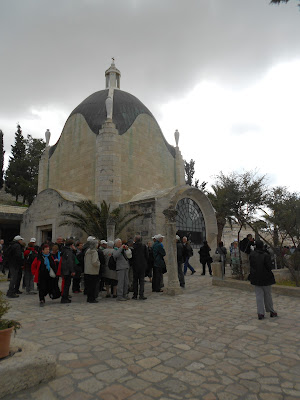 |
| across the Kidron Valley |
This is Jerusalem’s most important and most ancient cemetery, with around 70,000 or 150,000 tombs (depending on which source of information you use!) dating from some 3000 years ago to more recent times. Jews like to be buried here as in Jewish tradition the resurrection of the dead will start here when the Messiah comes. Here also is the place where Jesus ascended into heaven according to tradition.
The man with the donkey is annoyed I think that I did not give him any money, but others from our party did, so I thought another photo was not too much to ask of him! He didn’t agree!
Our first church to visit is the Paternoster Church, so called because by tradition this is where Jesus taught his disciples the Lord’s Prayer. The environs are already bustling with other coach parties and it is almost impossible to find any quiet space where we can say the Lord’s Prayer as a group.
I should mention here, in case anyone is wondering how our leaders keep tabs on us all, especially in such crowded places, that we each have a very nifty bit of technology – an ear piece through which we can hear our guide talking to us over a reasonable range, at a wavelength unique to each group. Wonderful! It means we can stroll around while listening to his talk and be called to regroup at any time when we are due to move on.
And move on we do; to Dominus Flevit, the Lord Wept, the church which commemorates the occasion when Jesus wept and foretold the destruction of the city below him…
 |
| Dominus Flevit |
The Dominus Flevit is tear-drop shaped and has a “tear cup”
at each of its four corners. This place speaks powerfully to me of the
vulnerability of Jesus, the Wounded Healer.
At the same time I am disturbed by
the litter, the peddlers or hawkers, and the crowds, all of which we must
somehow get used to as the week progresses...
This is only just the first morning of our pilgrimage so for some the transition has not yet been made from tourist to pilgrim - a process that will be different for each and every one of us. Who knows at this stage which experiences will move us most, which memories will be most important to each of us ...



No comments:
Post a Comment